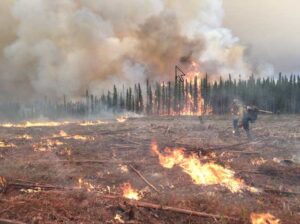
A wildfire burns on the Kenai National Wildlife Refuge in May 2014. The fire, which broke out following an early snowoff, consumed 200,000 acres, four structures and two outbuildings.
An early exit of Alaska’s spring snow means more acreage could burn during the coming wildfire season, which begins when the snow melts off, says new research from the University of Alaska Fairbanks
“The most significant finding is that during many of the largest, most extreme fire seasons, we had early snowoff,” explained Peter Bieniek, lead author of the study and a climate modeler at the UAF International Arctic Research Center. “During these years there are large-scale climate patterns that persist through time. They set up and keep a high pressure over Alaska.”
High pressure systems bring clear, sunny and warm weather. There isn’t a lot of rain, but in some cases there are thunderstorms. When these conditions last for months, they can lead to big fire seasons.
Three of Alaska’s four largest wildfire seasons occurred during years with earlier than average snowoff dates. Many Alaskans will remember these seasons. In 2004, 6 million acres burned, and another 4.4 million acres burned the next year. In 2015, 5.1 million acres burned. Years with early snowoff were also responsible for more than half of the historical area burned in Alaska.
But co-author Mitch Burgard reminded Alaskans that “just because the snow melted early, it’s too early to panic that we’re gonna have the biggest fire season we’ve ever seen.”
“It’s way too early for that,” Burgard said. “The odds of it are slightly higher, but a lot can happen between snowmelt and the end of the fire season.”
Burgard is a fire analyst with the UAF Alaska Fire Science Consortium who was a wildfire manager for 33 years and fought over 500 wildfires. He helped frame the research to make it relevant and useful for Alaska wildfire managers. He emphasized that if he were an Alaska wildfire manager, “I would look at tracking the snowoff date and being prepared on those earlier snowoff seasons.”
For the general public, Burgard said, there is a message too: “When the snow comes off your yard, that’s not too early to start thinking about fire. So taking your firewood off of the porch and doing a little bit of cleanup and fuel reduction around your home.”
Early snowoff accelerates the onset of an early fire season, the study noted. As snow melts, the darker ground absorbs more heat and warms the local area, making the recently exposed fuels more susceptible to burning.
In the Lower 48 states, spring often brings rains that delay the fire season. That’s not the case in Alaska. Bieniek’s research confirms what many wildfire managers already know — when the snow melts, it’s fire season.
Bieniek also found that snow is melting earlier than in the past, due to climate change. In Southcentral Alaska, average snowoff has come over four days earlier each decade since 1959. Even on the North Slope, where the trend was less extreme, snow now melts off two days earlier each decade. These trends are expected to continue into the future.
“For long-term fire planning, knowing that statistic is super valuable,” emphasized Burgard.
Burgard and Bieniek’s partnership represents an important and unique relationship between scientists and wildfire managers in Alaska, one that is facilitated by the Alaska Fire Science Consortium where Burgard works. These groups meet and communicate so that wildfire research focuses on the pressing needs of managers facing an era of longer, more severe fire seasons.
“We’ve got a good relationship with wildfire managers,” said Bieniek. “I think it’s probably one of the best collaborations that I’ve seen. I’ve even heard folks say that they wish that this existed outside of Alaska. Just how friendly and well integrated things are.”
The study is part of a larger effort to improve seasonal weather and climate forecasts so that managers can better prepare for the coming wildfire season. The topic was listed as a research need by the Alaska Wildland Fire Coordinating Group — the state, federal and Native land management agencies/owners that are responsible for fire management.
Other co-authors on the study include Chris Waigl, Uma Bhatt, Tom Ballinger, Rick Lader, Cecilia Borries-Strigle, Joshua Hostler, Elizabeth Fischer, Eric Stevens and Heidi Strader. The research was supported by the National Science Foundation’s Alaska Established Program to Stimulate Competitive Research.
